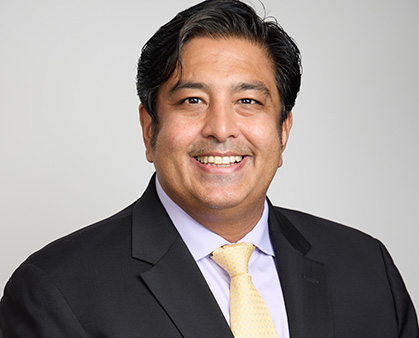A SPECIAL, NEW YEAR INVESTIGATIVE BLOG: Making Sense of Population Health, Precision Medicine & Value-Based Care with Mount Sinai’s Dr. Arshad Rahim
By Elise Wilfinger
01.06.2022

Introduction
For our first blog of 2022, we begin our 3-part series on value-based care and its intersection points with other healthcare strategies and with the healthcare ecosystem, at large.
American healthcare faces increasing challenges, including insufficient and inequitable access to care and coverage, the instability of publicly-funded programs, a dated infrastructure, and lagging use of technology.
We start our series with a discussion on how population health, precision medicine and value-based care can work together to address these challenges despite some commonly-held beliefs that they cannot co-exist.
I was fortunate to unearth key insights on this topic from Dr. Arshad Rahim, MD, MBA, FACP Internal Medicine who is an Assistant Professor and practicing physician with the Mount Sinai Health System in New York. Dr. Rahim also holds the position of Vice-President, Clinical Integration and Population Health, with responsibility for driving physician performance for the nearly 4,000 primary care providers at the Mount Sinai Clinically-Integrated Network. Additionally, he has helped steer a number of innovative healthcare businesses, including Mount Sinai Innovation Partners, Healthgrades, and Sg2, a health care and hospital system consultancy.
Elise:
Let’s start our discussion with your definition of population health.
Arshad:
Population health is about taking finite resources and applying them in the most innovative and efficient way (and at scale) to best meet the healthcare needs of a defined population.
We have major healthcare challenges in our country and population health strategies will help us organize the care delivery system to best drive value vs. volume.
“We must use population health strategies to change the trajectory of American healthcare.”
– Dr. Rahim
Elise:
What are the starting points of a strong population health strategy?
Arshad:
- We need to have a defined population.
It can be a population of patients with a particular disease, e.g., congestive heart failure or type 2 diabetes. It can also be a population of patients who are connected to certain primary care physicians in a geographic area or, potentially, a subsegment of patients within a particular state. - We need to further build relationships with the parties that are paying the bills.
The insurance company, payer or employer sets the parameters for a contractual arrangement, which is based on the care delivery system needed for the attributed population.
In order for us to change the trajectory of American healthcare, we need to find solutions for what’s been most challenging for us as a country – cost effective delivery of high quality healthcare. How and at what speed and scale may we use population health strategies to do just that? That’s what everyone should be asking.
Deeper dive: new health care models in action.
States, like Vermont and Maryland, are moving toward global healthcare budgets, hoping to quantitatively improve health and financial outcomes.
Vermont has implemented a long-term plan to combine a global payment model with community health teams responsible for coordinating care between the medical, social services and public health sectors. This global payment model is expected to encourage health systems to work with community health teams in a value vs volume mechanism, further driving population and patient health.
Maryland has also initiated an all-payer global budget program for acute-care hospitals in the state. The program limits growth in per-person total spending on hospital care to a predetermined percent each year. By setting limits on hospital spending, the program was designed to contain overall spending growth in Maryland and encourage hospitals to identify lower cost ways of delivering hospital-level care and dedicate the unspent resources to increasing the use of primary, upstream care.
Elise:
At face value, population health and precision medicine seem at odds with each other. Are they? If not, how do they co-exist?
Arshad:
No, but it’s a great question. They actually work symbiotically.
Population health focuses on the approximate ten steps taken to drive those key healthier habits that prevent and/or mitigate chronic disease, including managing to a healthy weight, managing blood pressure and blood sugar, regular activity and exercise, etc.
Precision medicine is supportive of population health goals upstream and downstream in disease states, examples include genetic screening to identity and stratify patients in pre-disease or early disease states such as diabetes or asthma or determining the most effective oncologic treatments.
The overarching question is: what is going on with the larger, general population and how can we tailor care for the higher risk subsegment that have complex chronic and/or progressing conditions?
Deeper dive: the co-existence of population health and precision medicine.
In his 2015 State of the Union Address, President Barack Obama announced that the government was launching the Precision Medicine Initiative, and all government/clinical stakeholders agreed that it needed to align with population health strategies.
At the time, these two working definitions demonstrated how these concepts could co-exist and complement each other:
Population health = improving clinical health outcomes of a defined group of individuals through improved care coordination and patient engagement supported by appropriate financial and care models.
Precision medicine = aligning the right drugs and treatments to the right people, based on a genetic or molecular understanding of their disease. It is an approach to patient care that is based on the idea that one patientʼs disease may not be the same in another patient who may also have the same disease.
Elise:
So, is precision medicine only at play for a subsegment of a larger population? Or is it also about the individual patient?
Arshad:
It’s both.
Precision medicine is about looking at the entire population and stratifying it. The stratification usually includes more than one individual, but it has to make sense at the individual patient level too. We tend to find trends at the individual level that can ladder up to a subsegment of the general population.
For example, we offer and recommend a mammogram to the general population, but we further risk stratify based on a patient’s genetic factors. If those factors warrant, we also conduct BRACA screening to identify those who are at higher risk for breast cancer. Both are supportive of the overall goal to drive better health for the total population.
“Health is something that happens every single day. Thinking of it in episodic terms won’t help us to have better quality of lives.”
– Dr. Rahim
Elise:
Is population health merely a great concept or is it being realized right now in the U.S.?
Arshad:
That gets right to the heart of the issue, doesn’t it?
The truth is, nationally, population health is still largely an aspirational idea vs a reality.
Although there has been substantial movement in the last eight years, there remains a need for payer incentives and provider investment, know-how and philosophical belief in the population health model to change a long-standing, entrenched, though inefficient, fee-for-service delivery infrastructure.
The good news: there is deep bipartisan support for population health. There is alignment for how healthcare should be delivered: (1) with coordinated care across all interactions in and out of a clinical setting (2) by connecting all constituents: the health system, the providers, the payers, the patients, and the families.
‘Health’ is something that happens every single day. Thinking about healthcare in episodic terms, won’t help any of us secure a longer, better quality of life.
“One reason most western industrialized countries implement better population health strategies than the U.S.: A stronger primary care infrastructure.”
– Dr. Rahim
Elise:
Are other countries pursuing and/or successfully implementing population health strategies?
Arshad:
The United States currently performs worse than any of the western industrialized countries; they all do it better than we do.
Two major reasons are (1) the primary care base is stronger in other countries, (2) the incentives are much better aligned to keeping citizens healthy through a population health and public health focus.
It’s interesting that people will come from all over the world to tap into our healthcare system, despite the fact that we don’t generate, comparatively, better outcomes. They travel here for specialty care not for primary care. An excessive focus on specialty care at the expense of incentivizing and nurturing primary care, can be counter to population health excellence.
Deeper dive: what can we learn from the Danish?
We must focus on population health strategies to improve patient outcomes and reduce unnecessary costs. Primary care services that can keep patients with non-emergency conditions out of the hospital are lacking. Many health systems are improving population health efforts by acquiring primary care practices and making independent physicians, employees of the health systems.
The Danish healthcare system is often singled out for its population health model due to its single-payer, taxpayer-funded financial structure that provides equal access to care for all Danish residents. All residents have access to a free primary care physician of their own choice, who becomes the gatekeeper for specialty services and hospital care. Danish primary care physicians operate as independent contractors for various health regions, which makes them invested in their ‘own business.’
Both the American and Danish healthcare systems are under pressure from the rise in aging populations with chronic diseases and multi-morbidities (e.g., cardiovascular diseases, diabetes, arthritis, cancer, neurological disorders). The Danish healthcare system, however, better enables a more integrated, preemptive, and cost-effective approach to care, which is essential to managing patients with many chronic conditions and high-volume use of healthcare services.
Similar models exist in Sweden, Norway, Finland and the United Kingdom.
“Healthcare is, most definitely, a team sport.”
– Dr. Rahim
Elise:
In these other countries, I’m assuming that it’s not just about the PCP infrastructure. It’s also about when the care is given. True?
Arshad:
Yes, exactly.
Select other countries, including Germany, organize around a primary case base. In these instances, the care goes well beyond the primary care provider: it’s the delivery infrastructure, the technology, the testing, the workflows, the patient engagement tools, etc. And it all needs to come together in the most comprehensive fashion: the right team, the right game plan, at the right time – which is upstream.
Elise:
In the context of this very connected, upstream care, who are the constituents and what roles do each play?
Arshad:
There is a much larger team and process infrastructure that must be considered in this care delivery model.
This “connected and coordinated” team includes primary care providers, specialty care providers (when appropriate), behavioral healthcare providers, care managers and social workers, nurses, patient engagement and outreach staff, home health workers, clinical pharmacists, pre-acute (paramedics, urgent care) and post-acute providers (aligned Skilled Nursing Facilities). Analytics are foundational to this team’s success. All of these constituents are essential parts of the delivery ecosystem to drive better outcomes.
“Wouldn’t a patient rather have a provider who is singularly focused on his/her patients’ healthier outcomes?”
– Dr. Rahim
Elise:
We’ve already touched on some of the principles of value-based care. Can you give us some more color as to where population health and value-based care intersect?
Arshad:
While everyone does not define them as such, I see population health and value-based care as synonymous terms.
At its core, value-based care is about paid for outcomes vs paid for volume of services provided. Population health thrives in a value-based care world. That’s why this is the model that Medicare decided to pursue in the last 10 years. They wanted to be a payer for value not for volume.
This model works best for patients too. Wouldn’t a patient rather have a provider who is singularly focused on his/her patients’ healthier outcomes?
Elise:
A value-based care model does seem like the ideal state. But does it work in poorer or underserved communities, where many may not have the money or the access to healthier foods, prescriptions, etc.?
Arshad:
It is likely the ideal model here, as poorer and underserved communities must be well managed to drive a sustainable financial model for care delivery. The care that is delivered must also appropriately account for medical and non-medical factors. These Social Determinants of Health (SDoH) – whether it’s food insecurity, housing insecurity, even educational insecurity – are all contributors to overall health outcomes.
There are different ‘pots of money’ that go toward providing healthcare in local and federal budgets. What if we took 10% off the top and used it to pay for these SDoH factors – not just pay for direct medical care. Could that be the game changer?
“In the middle of the health risk pyramid: substantial opportunity to prevent disease progression.”
– Dr. Rahim
Elise:
Does population health play an even more important role in chronic disease management?
Arshad:
Population health plays an important role across all tiers of the ‘health risk pyramid,’ including, but not limited to, chronic diseases.
For example, if you were to draw the pyramid, here is what it would look like.
The bottom of the pyramid is where you would find the healthier people, with less healthcare needs and less engagement required.
As we go up the pyramid, people get sicker.
The middle of the pyramid is where most patients with a chronic disease reside. It’s also where much of the cost exists. The good news: we can make a substantial difference in patient outcomes and cost, if disease interventions are put into place here, catching it before the patients move to the top of the pyramid.
At the top of the pyramid is where the most complex and complicated chronic disease patients reside, those who lean toward end-of-life needs.
Here is the rub: the middle tier has not been the focus in our country. That’s why they say that the U.S. healthcare system has been designed for sickness. If someone gets sick here, we throw the kitchen sink at him/her. This, of course, is not a cost-effective way to live longer, happier and healthier lives. We need to move care upstream – catching disease earlier – which, by the way, is fundamental to what makes population health work.
“Dealing with chronic kidney disease early on is critical. It’s often a leading contributor to many other disease states.”
– Dr. Rahim
Elise:
Are certain chronic diseases more appropriate for population health strategies? Perhaps, diabetes and/or kidney disease?
Arshad:
Like hypertension, diabetes and chronic kidney disease are relatively easy to identify, which makes them plausible case studies for population health.
It’s critical to deal with chronic kidney disease early on as it’s often a leading contributor to many other disease states.
“Many PCPs want to handle more of the care… upstream. They don’t want to be just a referral engine for specialty or downstream care.”
– Dr. Rahim
Elise:
Research indicates that awareness of kidney disease is limited among providers and patients. Furthermore, the right testing is often not done early on, when it matters most. Since you come from a primary care background, what is your take on this? What can be done to rectify this at the PCP level?
Arshad:
PCP education and presentation of the scientific underpinnings and clinical trials are foundational. Equally important is making the right thing to do, very easy to do, through team-based primary care support.
Many PCPs want to handle more of the care… upstream. They don’t want to be just a referral engine for specialty or downstream care.
That said, it is very hard to do what we’re talking about in the current infrastructure: a PCP often has at most 15 minutes to provide care to each patient. However, if they are to better manage care upfront, they need to be appropriately resourced and supported. Ultimately, time and aligned finances are part of the equation.
In general, to drive the value-based care model, we can’t just add more to what the PCP or specialist must do. That’s when we will get both resistance and lack of adoption. We have to rethink the way everything works today, reorganize, and make it financially feasible.
Elise:
It’s clear that all of this will take a lot more than a village. You mentioned that there is bipartisan support for value-based care and population health. Is there something that Biden’s administration is saying or doing now that makes you more hopeful that these strategies will be more fully realized?
Arshad:
President Biden has hired people who are both proponents of value-based care and have had experience within these delivery models. Thus, they are proponents and practitioners. The Administration has had its hands full with many priorities since January (e.g., COVID, Infrastructure Bill, etc.), so it’s unclear as to what the specifics of these strategies will be or when they will be implemented.
Side note: President Biden has made value-based care one of the cornerstones of his healthcare agenda. It joins, expanding the Affordable Care Act, reducing drug prices, and modernizing the FDA, as a key priority.
If you enjoyed this post, we’d be grateful if you would help us spread its content.

